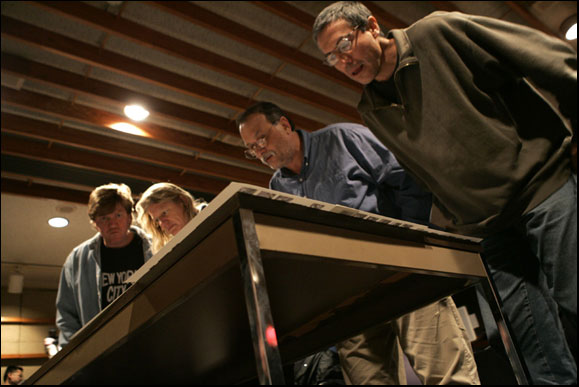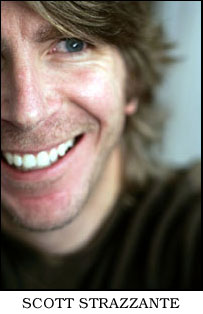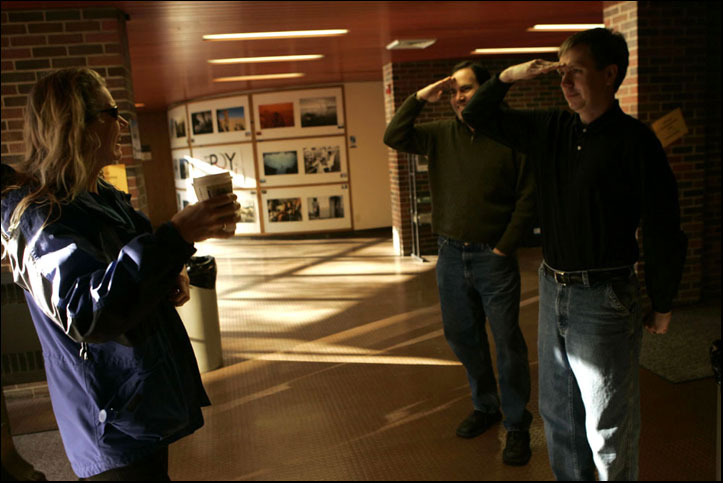EYE ON POYi
by Scott Strazzante
Staff Photographer
Chicago Tribune
It was just four short years
ago on a drizzly February Friday that I was privileged to be
sitting in Gannett Hall at the University of
Missouri watching as my portfolio bested 124 others giving
me the honor of being named 2000 National Newspaper Photographer of
the
Year.
My 2000 entry consisted entirely of photos made with film cameras
within 30 miles
of my newspaper’s office in Joliet, Illinois. In comparison my
100% digital portfolio this year was comprised of photos shot in Chicago,
Long
Beach, San
Francisco, Aspen, Puerto Rico, Switzerland, Slovakia, Bulgaria and Greece,
all within a mere 6000 miles of the Tribune Tower.
That radical change in my career and other photojournalism-related issues
were on my mind as I returned this year to that same hallowed hall to watch
as 4
judges decided what images, stories and portfolios would be called best of
2004.
As I sat watching the pixels fly by, I couldn’t help but ponder
some of the other changes that have happened since that late winter day
in 2001.
Of course,
the most obvious and far-reaching ones occurred in the aftermath of the
terrorist attacks of September 11, 2001. That event changed the face
of photojournalism
forever. Not only did it change the focus of our daily work but it also
changed the conditions in which we work under. These facts were very
evident in the
newspaper division news picture story category. The majority of the entries
were international,
with the bulk of those being from Haiti and Iraq. While most of the domestic
stories entered were hurricane coverage. The reportage from Haiti was
incredible. There were at least a dozen essays on the turmoil from early
2004 and all
gave a peek at the courage and resolve shown by the war photographers
working in
our profession. Most of the Iraq stories centered more on the daily life
of the GIs
overseas. This, I assume, was a result of the embedding process and the
incredible danger that a photographer on their own must encounter while
working in that
arena. Despite the wealth of stories from Haiti and Iraq, first place
in the category went to Andrea Bruce Woodall of the Washington Post.
Her piece
on
the Afghanistan elections was both beautiful and content-rich.
Another category, I was anxious to watch was the judging of the Newspaper
Photographer of the Year. This year’s judges- Peggy Peattie, staff
photographer, San Diego Tribune; Tim Rasmussen, DOP, South Florida Sun-Sentinel;
Stephan Savoia,
Associated Press national staff photographer and Jose Luis Villegas,
staff photographer, Sacramento Bee- had the overwhelming task of sorting
through
112 portfolios,
comprising over 3700 images, and then deciding which was the best. I
was curious to see if the international work would carry more weight
than the
domestic
or if a combination of the two would prove to be the winning combination.
© Photo by Scott Strazzante
February 25, 2005
POYi judging at University of Missouri, Columbia, Missouri
Dallas Morning News' Smiley Pool (right) and Chicago
Tribune's Alex Garcia jokingly salute POYi judge Peggey
Peattie as she arrives at Gannett Hall for the final
day of judging in the newspaper division |
|
I sat next to Dallas Morning
News photographer Smiley Pool for the entire 10 hours that it took
for the category to be judged. Smiley and I had a running
conversation, in whispered tones, throughout the day about the state
of photojournalism and the judging process in general. Our first
conclusion was that contests
suck, unless you win. Every set of judges comes in with a different
set of life experiences,
artistic sensibilities and professional standards. If you had ten sets
of qualified
professionals judging the same group of photos, I would guess that
there would be a small core of consistent winning images, about
25%, that would
be chosen
by almost all the groups. The other 75% of the awards would vary wildly.
Another variable is the judging criteria. Are the judges picking the
best of the year or do they use some sort of standard to compare the
entries
to and
then decide whether or not to award winners in a certain category?
The first two years
of judging at the NPPA’s BOP contest, no awards were given in the Sports
Portfolio category. This year in POYi, only two awards of excellence were awarded
in One Week’s Work. Is that right? I say no. I tend to lean towards
awarding at least 1st through 3rd places in every category. Besides
awarding the best
of a year, I believe major photo contests are a valuable historical
document. They give insight into the important events and issues of
the year and
show the prevailing styles that are employed by those deemed most successful.

©
Photo by Scott Strazzante February 25, 2005
POYi judging at University of Missouri, Columbia, Missouri
Tim Rasmussen, Peggy Peattie, Stephan Savoia and Jose Luis
Villegas scour the final portfolios on the Newspaper Photographer
of the Year category. |
|
As for the portfolio entries,
almost all, including the winning ones, could have used a bit more
editing. A good example was
LA Times’ Rick Loomis’ entry
that ended up placing 3rd in the portfolio category. (I’m not
trying to pick on my dear friend Rick, because my portfolio suffered
from a lack of editing,
too, but unlike Rick’s, it wasn’t good enough to overcome
it’s
flaws.) Loomis’ images ranged from pretty good to outstanding.
He was in the thick of battle in Iraq and came back not only in one
piece but with a handful
of emotionally gripping images that made you feel like you were right
there with the Marines as they fought for their lives in Fallujah.
His work in Haiti and
the Middle East was just as good. Loomis even included a photo from
one of Florida’s
hurricanes. So why did this portfolio only merit a 3rd? Too many
photos. Loomis entered the maximum 50 images that the rules allowed.
In fact,
I think, Loomis
had enough great photos this past year to have two award-winning
portfolios.

© Photo by Scott Strazzante February 25, 2005
POYi judging at University of Missouri, Columbia, Missouri
An image by Luis Sinco of the Los Angeles Times is viewed
during the Newspaper News Picture Story Category. |
|
So, my advice is, next year
when you sit down to access your work, have a couple people sit with
you and have an honest conversation
about the
work.
It’s
even more helpful if those helpers don’t work at your paper.
Sometimes, your fellow editors and photographers are too close
to the work and are swayed
by how it ran in the paper and not whether it can stand alone as
it enjoys it’s
1 second in the spotlight during the contest judging. If you decide
to enter a portfolio, remember less is more. Besides the editing,
sequencing and quality
summaries and captions are just as important. The portfolio judging
process is based on picking apart the redundancies and singling
out the poor images in a
body of work. The fewer photos in your portfolio that can be criticized,
the better off you’ll be.
Well as another contest season comes to a close, I, for one, am
glad that I made the pilgrimage to Columbia, Missouri. Looking
at the
best of the
best has once
again reconfirmed why I love this job. Now it’s time to go out and make
those photos that next year’s bleary-eyed POYi judges will
scrutinize and, hopefully, with a little luck, choose as the best.
Scott Strazzante
SStrazzante@tribune.com




